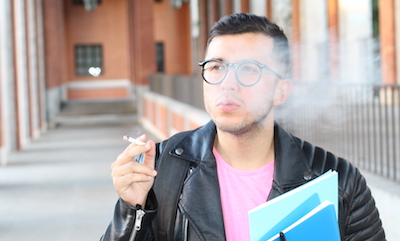New Science Survey: Coming Out as Bisexual is Linked to Smoking
 |
| Coming out gay made me smoke more on those times. I described my self as bisexual only because I could be but my choice if I was given one in an isolated island would be with a guy of my chouce not a girl. Adam |
Previous research suggests that LGB+ individuals are more likely to smoke cigarettes. However, a new study from the School of Public Health at Boston University (BU), MA, looks more closely at sexual identity and smoking.
The research finds that the association applies only to bisexual people, primarily during the first 3 years after coming out.
People coming out as bisexual are twice as likely to start smoking after coming out when compared to heterosexual, lesbian, gay, or other non-heterosexual people.
According to Andrew Stokes, the study’s corresponding author, the new research “highlights the importance of moving beyond static measures of sexual identity towards more dynamic measures that capture critical periods of vulnerability.”
This shift in the researchers’ perspectives, says lead author and doctoral candidate Alyssa Harlow, “turned out to be really important because it revealed disparities that would have otherwise been missed if we measured identity at one time point, or grouped all LGB+ identities together.”
The research appears in the journal JAMA Pediatrics. Stokes and Harlow were joined in the study by BU’s Dielle Lundberg, Julia Raifman, Carl Streed, and Emelia Benjamin, as well as Andy S.L. Tan of the University of Pennsylvania in Philadelphia.
The researchers followed 7,843 young people and young adults over 3 years by analyzing data from the nationwide Population Assessment of Tobacco and Health (PATH) study. The group, whose ages ranged between 14–29 years, was interviewed three times between 2013–2018.
“The PATH study is unique because it asks youth about their sexual orientation and gender identity. Most national surveys do not,” says Lundberg.
The researchers adjusted for a variety of factors, including individuals’ sex, age, education level for those over 18, their parents’ level of education, race, ethnicity, and where they lived.
One limitation of the study is that there were not enough transgender participants in the original survey to consider the group sufficiently represented, so the new research applies only to LGB+ individuals.
By the final round of interviews, 14% of the PATH participants reported having smoked cigarettes, while 6% were current smokers.
While initial analysis of the entire LGB+ group supports the doubled likelihood of being a smoker, breaking down the data by sexual identity revealed that it applied only to bisexual individuals. This association applied equally to those who had once smoked and to those who still did.
Individuals who had maintained the same LGB+ status throughout the 3 years were no more likely to smoke than people with a constant heterosexual identification.
The bisexual individuals who had just come out — moving from one identity to another during the 3-year survey period — were found to be the only group that was twice as likely to start smoking.
“The findings point to a need for public health interventions specifically designed to address the unique needs, experiences, and stressors associated with coming out and identifying as bisexual,” according to Harlow, who notes that bisexual people “may experience stigma from heterosexual individuals as well as from within the LGB+ community.”
Harlow adds, “There’s also prior research showing that bisexual populations have worse mental health outcomes than LG+ populations.”
Comments